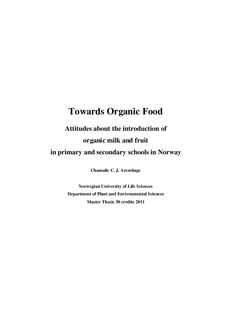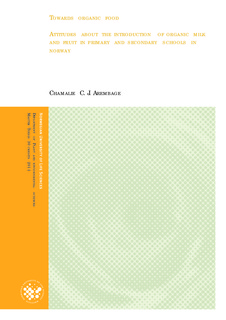| dc.contributor.author | Arembage, Chamalie | |
| dc.date.accessioned | 2012-05-18T12:33:28Z | |
| dc.date.available | 2012-05-18T12:33:28Z | |
| dc.date.issued | 2012-05-18 | |
| dc.identifier.uri | http://hdl.handle.net/11250/189528 | |
| dc.description.abstract | Norwegian consumers are becoming increasingly interested in organic food and the government is setting goals with regard to production and consumption. The “Økoløft project” is one of the strategies developed by the government to help realise an increase in organic production and public sector consumption. Schools are one public sector setting where organic food consumption has started to grow to counter the predominance of unhealthy food patterns among children. Yet schools as public sector institutes are poorly considered in the government goals related to organic food. This study explores the attitudes about the introduction of organic milk and fruit in primary and secondary schools in Norway. Attitudes and opinions of the school food actors at different levels were investigated. The study was conducted on two levels; food actors at the decision making level through interviews and food actors at the implementation level through a web based survey. The majority of the school administrators agree that skolefrukt and skolemelk programs represent a good opportunity to introduce organic produce into Norwegian schools. This is reflected in the 80% schools which did not have organic produce in their schools agree on free skolefrukt as the best scheme to introduce organic produce where subscription based skolefrukt program was considered as the next best. Third was the skolemelk program.
Organic agriculture as an environmentally friendly practice; as a way of diminishing social inequalities and provides equal access for fruit; as a convenient way to get fruit and milk; as a tool of gaining knowledge; ban of harmful chemicals and pesticides is perceived by the school administration to be the most important supporting factors to the inclusion of organic fruit and milk into the schools. The hindrances identified were skolemelk and subscription based skolefrukt as creation of discrimination between the children, inadequate budget due to the high cost of organic food, an assumption that conventional Norwegian fruit should be given priority over imported organic fruit, a preference to allocate funding towards learning facilities rather than food. At the decision making level hindrances include a lack of coordination between government actors, the freedom to use the free skolefrukt budget for other purposes, the high cost of organic produce and the fact that the organic market in Norway is at its early stages of development. Supporting factors were motivated actors, the national goal for a clean environment, and practical implementing projects such as Økoløft.
The Økoløft project as well as schools that have environmental certification programs such as, Eco- School certification (Miljøfyrtårnsertifisert and Children’s Green City (Grønt Flagg-sertifisert) has influenced schools to use organic products. A higher consumption of organic produce in the schools involved with Økoløft project may be due to the access they had to more knowledge about organic produce and how to put this knowledge into practice.
It can conclude that factors to support and hinder the inclusion of organic fruit and milk into schools seem to be interrelated. The initiatives aimed at developing school food programs should therefore take this complexity into consideration and adopt multi-faceted strategies that draw knowledge from the actors within the wider system in which schools are embedded as a means to promote organic consumption. | no_NO |
| dc.description.sponsorship | TINE | no_NO |
| dc.language.iso | eng | no_NO |
| dc.publisher | Norwegian University of Life Sciences, Ås | |
| dc.subject | organic foods | no_NO |
| dc.subject | school meals | no_NO |
| dc.subject | agroecology | no_NO |
| dc.subject | surveys | no_NO |
| dc.subject | organic amendments | no_NO |
| dc.subject | organically grown products | no_NO |
| dc.subject | Norway | no_NO |
| dc.title | Towards organic food : attitudes about the introduction of organic milk and fruit in primary and secondary schools in Norway | no_NO |
| dc.type | Master thesis | no_NO |
| dc.subject.nsi | VDP::Agriculture and fishery disciplines: 900::Agriculture disciplines: 910 | no_NO |
| dc.subject.nsi | VDP::Mathematics and natural science: 400::Zoology and botany: 480::Ecology: 488 | no_NO |
| dc.source.pagenumber | 121 | no_NO |

